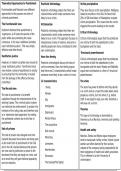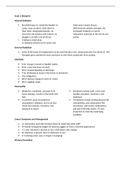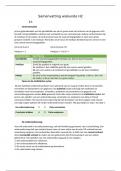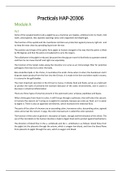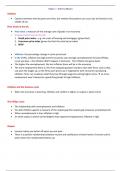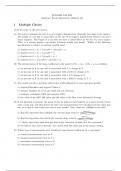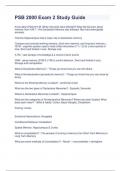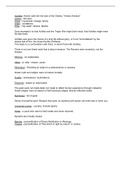Theoretical Approaches to Punishment Positivist Victimology Victim precipitation
Functionalists and Marxists have different Positivist victimology states that there are They also discuss victim precipitation. Wolfgang
approaches to the purpose and aims of characteristics which make someone more looked at murders in the USA. He found that
criminal punishment. likely to be a victim. 26% of 588 homicides in Philadelphia involved
victim precipitation. This means that the victim
The Functionalist view Victimisation
triggered the events leading to the murder.
Durkheim believed that punishment is Positivist victimology states that there are
Critical Victimology
‘expressive’ as it heals the wounds of the characteristics which make someone more
public while also promoting the value likely to be a victim. This approach focuses on Critical victimologists argue that the proletariat
consensus. In his view, traditional societies interpersonal crimes of violence and aims to are victims of both the exploitation by the
used ‘retributive justice’. This was simple, identify people who have contributed to their bourgeoisie and the state.
effective and often brutal. own victimisation.
‘Structural powerlessness’
Restitutive justice Hans Von Hentig
Critical victimologists argue that the proletariat
However, in modern societies have moved to Positivist victimologists discuss the idea of are victims of both the exploitation by the
using ‘restitutive justice’. Punishment must victim proneness. Hans Von Hentig argues bourgeoisie and the state. Mawby and Walklate
now restore a sense of equilibrium to society that there are 13 characteristics which make argue that victimisation is a form of ‘structural
by ensuring that the community is healed someone more likely to be a victim of crime. powerlessness’.
from the damage of the offence that was
committed. 13 characteristics The state
The Marxist view · Young. The state has power to define who they decide
is a victim and as a result the state labels some
The role of punishment is to benefit · Female.
people as victims, but not others. E.g. before
capitalism through the imprisonment of the · Old. 1991 it was legal to rape your wife, therefore a
working classes. The criminal justice system wife was not a victim.
use ‘selective law enforcement’ to protect the · Immigrants.
interests of the ruling class and therefore acts Theories
· Depressed.
as a ‘repressive state apparatus’ by making This type of victimology is dominated by
the proletariat conform due to the fear of · Mental illness. theories such as Marxists, feminists and labelling
punishment. theorists.
· The acquisitive.
Role of prisons Health and safety
· Dull normal.
The role of prisons has changed over time. Marxists, Tombs and Whyte argue employers
· Minorities.
Garland discusses how prisons are being used tend to manipulate ‘safety crimes’ where injured
as the main form of punishment in the USA · Lonesome. workers are often blamed for their actions
and in the UK. Garland believes that prisons instead of the company taking responsibility for
are now used by politicians to prove to the · Heartbroken.
their negligence of health and safety procedure.
electorate that they are tough on crime, and · Tormentor. This is referred to as the ‘hierarchy of
as a result they will gain electoral popularity victimisation’.
and win elections. · The blocked/The fighter.
Functionalists and Marxists have different Positivist victimology states that there are They also discuss victim precipitation. Wolfgang
approaches to the purpose and aims of characteristics which make someone more looked at murders in the USA. He found that
criminal punishment. likely to be a victim. 26% of 588 homicides in Philadelphia involved
victim precipitation. This means that the victim
The Functionalist view Victimisation
triggered the events leading to the murder.
Durkheim believed that punishment is Positivist victimology states that there are
Critical Victimology
‘expressive’ as it heals the wounds of the characteristics which make someone more
public while also promoting the value likely to be a victim. This approach focuses on Critical victimologists argue that the proletariat
consensus. In his view, traditional societies interpersonal crimes of violence and aims to are victims of both the exploitation by the
used ‘retributive justice’. This was simple, identify people who have contributed to their bourgeoisie and the state.
effective and often brutal. own victimisation.
‘Structural powerlessness’
Restitutive justice Hans Von Hentig
Critical victimologists argue that the proletariat
However, in modern societies have moved to Positivist victimologists discuss the idea of are victims of both the exploitation by the
using ‘restitutive justice’. Punishment must victim proneness. Hans Von Hentig argues bourgeoisie and the state. Mawby and Walklate
now restore a sense of equilibrium to society that there are 13 characteristics which make argue that victimisation is a form of ‘structural
by ensuring that the community is healed someone more likely to be a victim of crime. powerlessness’.
from the damage of the offence that was
committed. 13 characteristics The state
The Marxist view · Young. The state has power to define who they decide
is a victim and as a result the state labels some
The role of punishment is to benefit · Female.
people as victims, but not others. E.g. before
capitalism through the imprisonment of the · Old. 1991 it was legal to rape your wife, therefore a
working classes. The criminal justice system wife was not a victim.
use ‘selective law enforcement’ to protect the · Immigrants.
interests of the ruling class and therefore acts Theories
· Depressed.
as a ‘repressive state apparatus’ by making This type of victimology is dominated by
the proletariat conform due to the fear of · Mental illness. theories such as Marxists, feminists and labelling
punishment. theorists.
· The acquisitive.
Role of prisons Health and safety
· Dull normal.
The role of prisons has changed over time. Marxists, Tombs and Whyte argue employers
· Minorities.
Garland discusses how prisons are being used tend to manipulate ‘safety crimes’ where injured
as the main form of punishment in the USA · Lonesome. workers are often blamed for their actions
and in the UK. Garland believes that prisons instead of the company taking responsibility for
are now used by politicians to prove to the · Heartbroken.
their negligence of health and safety procedure.
electorate that they are tough on crime, and · Tormentor. This is referred to as the ‘hierarchy of
as a result they will gain electoral popularity victimisation’.
and win elections. · The blocked/The fighter.

